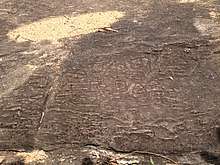Muwangala Raja Maha Vihara
| Muwangala Raja Maha Vihara | |
|---|---|
| මුවංගල රජ මහා විහාරය | |
 The Stupa of Muwangala Raja Maha Vihara | |
| Basic information | |
| Location | Muwangala, Hingurana |
| Geographic coordinates | 07°15′00.7″N 81°39′50.0″E / 7.250194°N 81.663889°ECoordinates: 07°15′00.7″N 81°39′50.0″E / 7.250194°N 81.663889°E |
| Affiliation | Buddhism |
| District | Ampara |
| Province | Eastern Province |
| Country | Sri Lanka |
| Heritage designation | Archaeological protected monument (26 December 2014) |
| Architectural type | Buddhist Temple |
Muwangala Raja Maha Vihara (also known as Digamadulle Purana Raja Maha Vihara) (Sinhalese: මුවංගල රජ මහා විහාරය හෝ දිගාමඩුල්ලේ පුරාණ රජ මහා විහාරය) is an ancient Buddhist temple in Muwangala, Sri Lanka. The temple is located on Hingurana – Ampara road approximately 3 km (1.9 mi) distance from Hingurana town. The temple has been formally recognised by the Government as an archaeological site in Sri Lanka. The designation was declared on 26 December 2014 under the government Gazette number 1895.[1]
The temple
The temple complex at Muwangala has been constructed on two rocky outcrops between Ampara and Hingurana.[3] The modern buildings of the temple are situated at the lower ground of the mountain and the ruined structures of the ancient temple are scattered on the top of rocky plateau. Among the ancient structures, Sri Pathul Gal (slabs of Buddha footprint), an Asanaghara, pieces of Sandakada pahana, plight of steps, rock inscriptions, a drip ledged cave, bases of buildings and pillars can be identified. Before the construction of Buddha statues, people used various objects such as Asanaghara and Sri Pathul Gal to represent Buddha. Therefore, the presence of Sri Pathul Gal or Asanaghara in a temple is considered by the archaeology as an indicator that the temple was there before the Buddha statues were built in the country.[4]
References
- ↑ Gazette 1895 & 26 December 2014, p. 1148.
- ↑ Wijesekera, Nandadeva (1990). Archaeological Department Centenary (1890-1990): Inscriptions. Volume 2 of Archaeological Department Centenary (1890-1990): Commemorative Series. Commissioner of Archaeology, 1990.
- ↑ "Muwangala Rajamaha Viharaya Archaeological Site – මුවන්ගල රජමහා විහාරය පුරාවිද්යා භූමිය". amazinglanka. Retrieved 1 September 2017.
- ↑ Wijethunga, Sirisaman (20 March 2017). "සිරිපතුල් වන්දනාව (in Sinhala)". Budu Sarana, Associated Newspapers of Ceylon Limited. Retrieved 1 September 2017.
ඉතාම පැරණි පුදබිමක් ලෙසින් හඳුනා ගැනීමට නිශ්චිත පුරාවිද්යාත්මක සාක්ෂියක් ලෙසින් පුරාවිද්යාඥයෝ සිරිපතුල් ගල් හඳුන්වති
External links
- "PART I : SECTION (I) — GENERAL Government Notifications" (PDF). The Gazette of the Democratic Socialist Republic of Sri Lanka. 1895. 26 December 2014.
